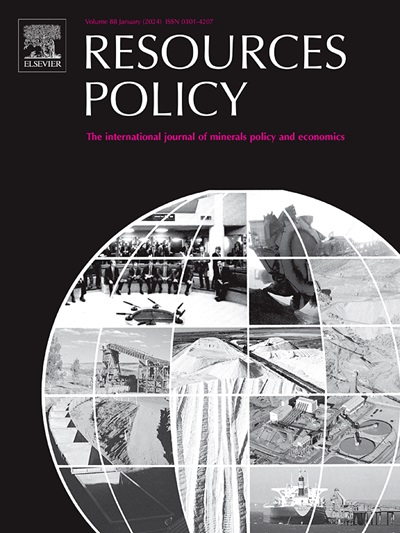Exploring mining extraction dynamics in Africa: A Hotelling model perspective with non-linear costs
IF 10.2
2区 经济学
0 ENVIRONMENTAL STUDIES
引用次数: 0
Abstract
This paper assesses the applicability of the Hotelling model to non-renewable resource extraction in Africa by examining seven key minerals (bauxite, copper, gold, iron, nickel, phosphate, and tin) across 18 major producing countries. Our findings systematically reject the Hotelling model’s predictions: estimated discount rates are significantly negative across most countries and commodities, contradicting the theoretical assumption of intertemporal profit maximization. Furthermore, observed depletion times (averaging 105 years) fall markedly short of theoretical optima (240–256 years), suggesting systemic over-extraction. Results vary substantially by mineral and country, with phosphate reserves (e.g., Morocco) showing slower depletion, while copper and gold sectors (e.g., DRC, Ghana) exhibit faster extraction. These deviations suggest that the Hotelling model may be inadequate for capturing the complex realities of resource extraction in developing economies, where factors such as widespread illegal mining, institutional rigidities, political instability, and regulatory weaknesses that facilitate resource predation create different optimization conditions than those assumed by the classical model.
探索非洲的采矿开采动态:具有非线性成本的Hotelling模型视角
本文通过考察18个主要生产国的7种关键矿物(铝土矿、铜、金、铁、镍、磷酸盐和锡),评估了Hotelling模型在非洲不可再生资源开采中的适用性。我们的研究结果系统性地否定了Hotelling模型的预测:估计的贴现率在大多数国家和商品中都是显著负的,这与跨期利润最大化的理论假设相矛盾。此外,观测到的枯竭时间(平均105年)明显低于理论最佳值(240-256年),表明系统过度开采。不同矿物和国家的结果差别很大,磷酸盐储量(如摩洛哥)的枯竭速度较慢,而铜和黄金部门(如刚果民主共和国、加纳)的开采速度较快。这些偏差表明,霍特林模型可能不足以捕捉发展中经济体中资源开采的复杂现实,在发展中经济体中,广泛的非法采矿、制度僵化、政治不稳定和监管薄弱等因素助长了资源掠夺,这些因素创造了与经典模型假设的不同的优化条件。
本文章由计算机程序翻译,如有差异,请以英文原文为准。
求助全文
约1分钟内获得全文
求助全文
来源期刊

Resources Policy
ENVIRONMENTAL STUDIES-
CiteScore
13.40
自引率
23.50%
发文量
602
审稿时长
69 days
期刊介绍:
Resources Policy is an international journal focused on the economics and policy aspects of mineral and fossil fuel extraction, production, and utilization. It targets individuals in academia, government, and industry. The journal seeks original research submissions analyzing public policy, economics, social science, geography, and finance in the fields of mining, non-fuel minerals, energy minerals, fossil fuels, and metals. Mineral economics topics covered include mineral market analysis, price analysis, project evaluation, mining and sustainable development, mineral resource rents, resource curse, mineral wealth and corruption, mineral taxation and regulation, strategic minerals and their supply, and the impact of mineral development on local communities and indigenous populations. The journal specifically excludes papers with agriculture, forestry, or fisheries as their primary focus.
 求助内容:
求助内容: 应助结果提醒方式:
应助结果提醒方式:


